The ingestible sensors market is projected to grow from USD 983.6 million in 2025 to approximately USD 1,696.1 million by 2035, recording an absolute increase of USD 712.5 million over the forecast period. This translates into a total growth of 72.4%, with the market forecast to expand at a compound annual growth rate (CAGR) of 5.6% between 2025 and 2035. The overall market size is expected to grow by nearly 1.7X during the same period, supported by increasing adoption of digital health monitoring solutions, rising demand for non-invasive diagnostic tools, and growing focus on medication adherence monitoring.
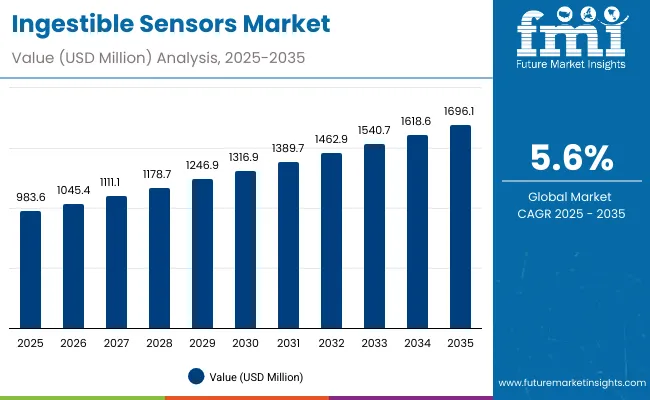
Ingestible Sensors Market Key Takeaways
| Metric | Value |
|---|---|
| Estimated Value in (2025E) | USD 983.6 million |
| Forecast Value in (2035F) | USD 1,696.1 million |
| Forecast CAGR (2025 to 2035) | 5.6% |
Between 2025 and 2030, the ingestible sensors market is projected to expand from USD 983.6 million to USD 1,291.6 million, resulting in a value increase of USD 308.0 million, which represents 43.2% of the total forecast growth for the decade. This phase of growth will be shaped by rising awareness about remote patient monitoring solutions, increasing demand for personalized healthcare approaches, and growing penetration of digital therapeutics in emerging markets. Healthcare providers are expanding their ingestible sensor adoption to address the growing demand for effective patient monitoring solutions for chronic disease management.
From 2030 to 2035, the market is forecast to grow from USD 1,291.6 million to USD 1,696.1 million, adding another USD 404.5 million, which constitutes 56.8% of the overall ten-year expansion. This period is expected to be characterized by expansion of specialized healthcare monitoring channels, integration of artificial intelligence with sensor technology, and development of personalized diagnostic protocols. The growing adoption of evidence-based medicine and healthcare provider recommendations will drive demand for clinically proven ingestible sensors with enhanced accuracy and safety profiles.
Between 2020 and 2025, the ingestible sensors market experienced steady expansion, driven by increasing recognition of medication adherence challenges and growing acceptance of digital health monitoring approaches. The market developed as healthcare providers recognized the need for comprehensive monitoring solutions to address chronic disease management. Clinical research and regulatory approvals began emphasizing the importance of ingestible sensors in achieving better patient outcomes for medication compliance and physiological monitoring.
Market expansion is being supported by the increasing prevalence of chronic diseases and the corresponding demand for continuous patient monitoring approaches. Modern healthcare providers are increasingly focused on sensor technologies that can provide real-time physiological data, improve medication adherence, and reduce the burden of frequent clinical visits. The proven efficacy of ingestible sensors in monitoring conditions like gastrointestinal disorders, medication compliance, and vital signs makes them essential components of comprehensive healthcare monitoring plans.
The growing emphasis on personalized medicine and precision healthcare is driving demand for tailored sensor technologies that address individual patient needs and health profiles. Healthcare provider preference for non-invasive monitoring solutions that combine multiple sensing capabilities in single devices is creating opportunities for innovative sensor development. The rising influence of clinical guidelines and evidence-based treatment protocols is also contributing to increased adoption of proven ingestible sensor technologies across different patient populations and therapeutic areas.
The market is segmented by sensor type, function, end use, and region. By sensor type, the market is divided into temperature, pressure, pH, and image/imaging sensors. Based on function, the market is categorized into monitoring/adherence, imaging/diagnostics, and drug delivery trigger applications. In terms of end use, the market is segmented into healthcare, sports/fitness, military, and other applications. Regionally, the market is divided into North America, Europe, East Asia, South Asia & Pacific, Latin America, and Middle East & Africa.
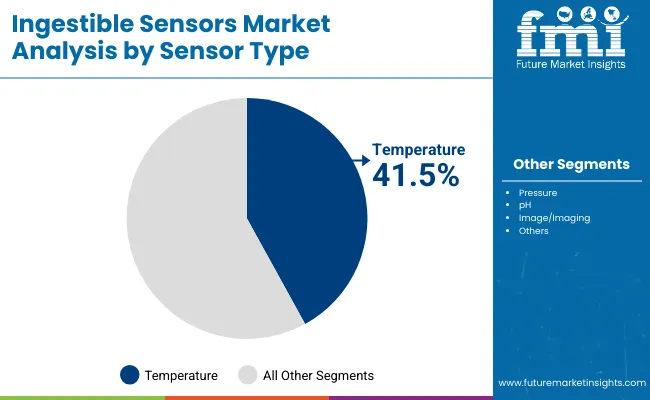
The temperature sensor segment is projected to account for 41.5% of the ingestible sensors market in 2025, reaffirming its position as the category's dominant sensor type. Healthcare providers increasingly recognize the critical importance of continuous temperature monitoring for detecting infections, inflammatory conditions, and metabolic disorders through minimally invasive sensor technology. This sensor type addresses core physiological monitoring needs and provides essential diagnostic information for various medical conditions.
This sensor type forms the foundation of most monitoring protocols for chronic health conditions, as it represents the most clinically validated and widely accepted sensing approach in digital health. Regulatory approvals and extensive clinical research continue to strengthen confidence in these sensor formulations. With increasing recognition of the importance of continuous physiological monitoring requiring multi-parameter approaches, temperature sensors align with both acute monitoring and long-term health management goals. Their broad therapeutic utility across multiple indications ensures sustained market dominance, making them the central growth driver of ingestible sensor demand.
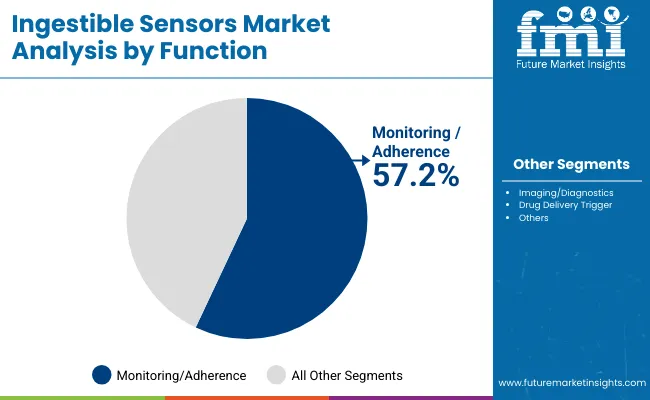
Monitoring/adherence function is projected to represent 57.2% of ingestible sensors demand in 2025, underscoring their role as the primary function driving sensor adoption. Healthcare providers recognize that medication adherence and continuous physiological monitoring require sophisticated sensing technologies that traditional monitoring methods cannot adequately address. Sensor technologies offer enhanced capabilities in tracking medication intake, physiological parameters, and treatment compliance.
The segment is supported by the chronic nature of many health conditions requiring long-term monitoring and the growing recognition that sensor approaches can improve patient outcomes and quality of life. Additionally, healthcare systems are increasingly adopting evidence-based monitoring guidelines that recommend specific sensor technologies for optimal patient management. As clinical understanding of chronic disease management advances, monitoring and adherence applications will continue to play a crucial role in comprehensive healthcare strategies, reinforcing their essential position within the ingestible sensors market.
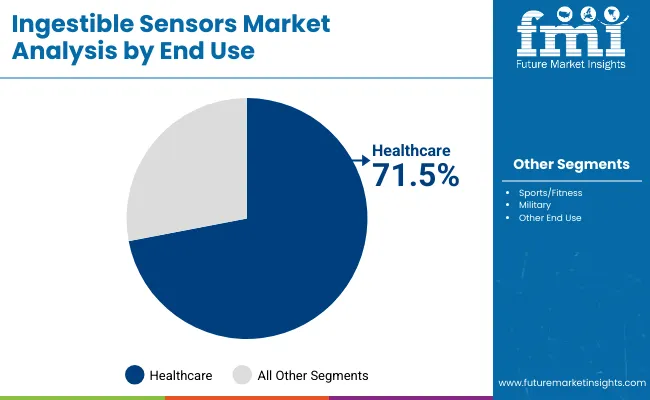
The healthcare channel is forecasted to contribute 71.5% of the ingestible sensors market in 2025, reflecting the primary role of medical institutions in sensor-based patient monitoring and care. Patients with chronic health conditions rely on healthcare providers for sophisticated monitoring solutions, making healthcare facilities the cornerstone of ingestible sensor utilization. This channel provides essential services including sensor deployment, data interpretation, and coordination with treatment protocols.
The segment benefits from established relationships between patients and healthcare providers, who provide continuity of care and monitoring support. Healthcare facilities also offer advantages in terms of clinical expertise, data analysis capabilities, and integration with electronic health records. With growing emphasis on precision medicine and patient-centered healthcare services, medical institutions serve as critical deployment points for ingestible sensors, making them fundamental drivers of market accessibility and growth.
The ingestible sensors market is advancing steadily due to increasing recognition of medication adherence challenges and growing demand for non-invasive monitoring approaches. However, the market faces challenges including complex regulatory pathways, potential for patient safety concerns, and issues with data privacy and security. Innovation in sensor miniaturization and wireless communication technologies continue to influence product development and market expansion patterns.
Expansion of Digital Health Platforms and Remote Monitoring Systems
The growing adoption of telemedicine and remote patient monitoring is enabling more sophisticated sensor-based healthcare delivery and patient management. Digital health platforms offer comprehensive data collection services, including real-time physiological monitoring and medication adherence tracking, that are particularly important for managing chronic conditions remotely. Remote monitoring systems provide access to continuous patient data that can optimize treatment protocols and medication management.
Integration of Artificial Intelligence and Machine Learning Technologies
Modern healthcare companies are incorporating artificial intelligence technologies such as predictive analytics, pattern recognition systems, and automated alert generation to enhance sensor-based monitoring capabilities. These technologies improve diagnostic accuracy, enable real-time health status assessment, and provide better coordination between healthcare providers and patients. Advanced AI platforms also enable personalized health recommendations and early identification of potential health complications or medication issues.
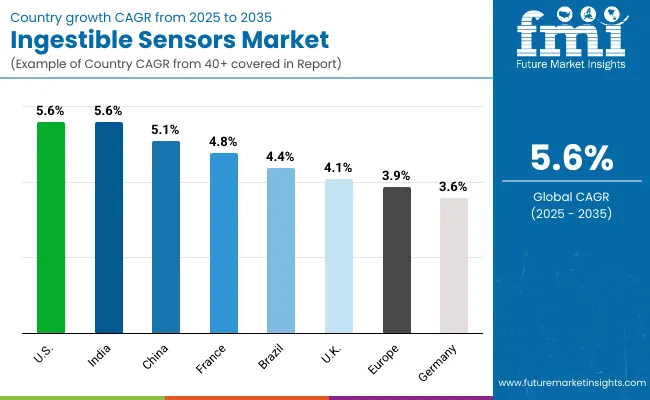
| Country | CAGR (2025 to 2035) |
|---|---|
| USA | 5.6% |
| India | 5.6% |
| China | 5.1% |
| UK | 4.1% |
| Brazil | 4.4% |
| France | 4.8% |
| Germany | 3.6% |
The ingestible sensors market is experiencing varied growth globally, with the USA and India both leading at a 5.6% CAGR through 2035, driven by expanding digital health infrastructure, increasing chronic disease prevalence, and growing access to advanced medical technologies. China follows at 5.1%, supported by healthcare system modernization, increasing recognition of preventive medicine importance, and expanding sensor technology adoption. Brazil shows growth at 4.4%, emphasizing improved access to digital health solutions and sensor technology adoption. Europe records 3.9% growth, focusing on evidence-based monitoring protocols and comprehensive healthcare systems. Germany shows 3.6% growth, representing a mature market with established monitoring patterns and regulatory frameworks.
The report covers an in-depth analysis of 40+ countries; seven top-performing countries are highlighted below.
Revenue from ingestible sensors in China is projected to exhibit steady growth with a CAGR of 5.1% through 2035, driven by ongoing healthcare system modernization and increasing recognition of digital health as a priority healthcare solution. The country's expanding healthcare infrastructure and growing availability of specialized monitoring services are creating significant opportunities for sensor technology adoption. Major international and domestic technology companies are establishing comprehensive distribution networks to serve the growing population of patients requiring continuous health monitoring across urban and developing regions.
Revenue from ingestible sensors in India is expanding at a CAGR of 5.6%, supported by increasing healthcare accessibility, growing chronic disease awareness, and expanding digital health market presence. The country's large patient population and increasing recognition of preventive medicine are driving demand for effective sensor monitoring solutions. International technology companies and domestic manufacturers are establishing distribution channels to serve the growing demand for quality healthcare monitoring technologies.
Demand for ingestible sensors in the USA is projected to grow at a CAGR of 5.6%, supported by well-established digital health systems and evidence-based monitoring guidelines. American healthcare providers consistently utilize sensor technologies for chronic disease management and preventive care applications. The market is characterized by mature monitoring protocols, comprehensive insurance coverage, and established relationships between healthcare providers and technology companies.
Revenue from ingestible sensors in Brazil is projected to grow at a CAGR of 4.4% through 2035, driven by healthcare system development, increasing access to digital health solutions, and growing recognition of chronic disease management importance. Brazilian healthcare providers are increasingly adopting sensor technology approaches for complex medical conditions, supported by expanding technology market presence and improved monitoring accessibility.
Revenue from ingestible sensors in the UK is projected to grow at a CAGR of 4.1% through 2035, supported by the National Health Service framework and comprehensive evidence-based monitoring guidelines that facilitate appropriate use of sensor technologies for chronic disease management. British healthcare providers consistently utilize established protocols for sensor technology management, emphasizing patient outcomes and monitoring optimization within integrated care systems.
Revenue from ingestible sensors in Germany is projected to grow at a CAGR of 3.6% through 2035, supported by the country's well-established healthcare infrastructure, comprehensive healthcare coverage, and systematic approach to digital health monitoring. German healthcare providers emphasize evidence-based sensor technology utilization within structured healthcare frameworks that prioritize clinical effectiveness and patient safety.
Revenue from ingestible sensors in France is projected to grow at a CAGR of 4.8% through 2035, supported by the country's comprehensive healthcare system, established medical care infrastructure, and systematic approach to digital health monitoring. French healthcare providers emphasize evidence-based sensor technology utilization within integrated care frameworks that prioritize patient outcomes and monitoring continuity.
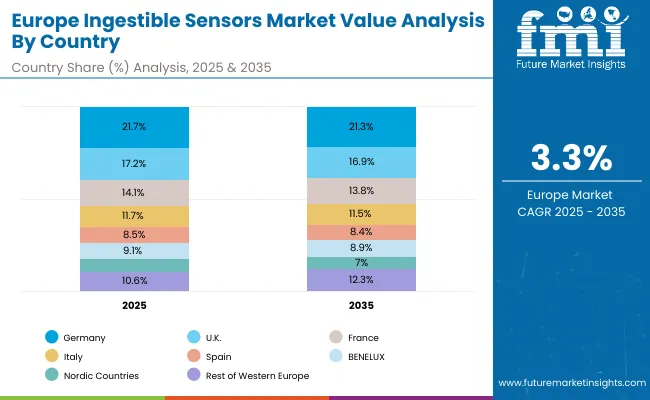
The ingestible sensors market in Europe is projected to expand steadily through 2035, supported by increasing adoption of digital health technologies, rising prevalence of chronic diseases, and ongoing clinical innovation in sensor-based monitoring solutions. Germany will continue to lead the regional market, accounting for 21.7% in 2025 and declining slightly to 21.3% by 2035, supported by a strong clinical research base, reimbursement pathways, and robust healthcare infrastructure. The United Kingdom follows with 17.2% in 2025, decreasing to 16.9% by 2035, driven by NHS adoption of advanced monitoring guidelines, digital health integration, and broadening specialist networks.
France holds 14.1% in 2025, declining to 13.8% by 2035 as other markets expand sensor technology adoption and demand grows for personalized monitoring solutions. Italy contributes 11.7% in 2025, decreasing to 11.5% by 2035, supported by regional healthcare programs and growing clinical research participation. Spain represents 8.5% in 2025, declining to 8.4% by 2035, underpinned by strengthening access to digital health services and patient monitoring programs.
BENELUX markets together account for 9.1% in 2025, moving to 8.9% by 2035, supported by innovation-friendly regulatory frameworks and academic-industry collaboration. The Nordic countries represent 7.1% in 2025, declining to 7.0% by 2035, with demand fueled by progressive healthcare systems and early adoption of evidence-based digital health solutions. The Rest of Western Europe increases from 10.6% in 2025 to 12.3% by 2035, as emerging markets capture greater share of investment, clinical trials, and adoption of sensor technology protocols.
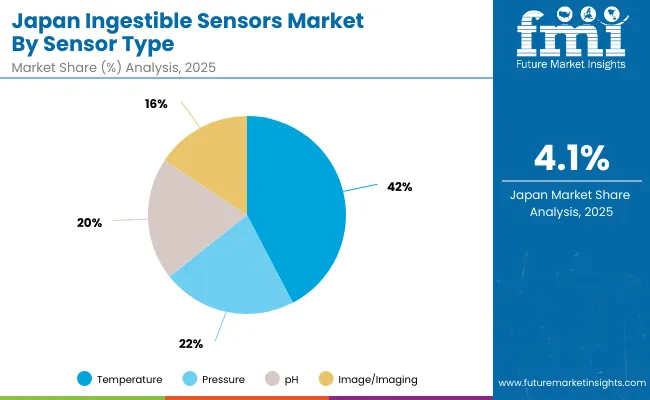
The ingestible sensors market in Japan is set to remain diversified across several sensor technologies in 2025, reflecting clinical preferences in digital health practice and evolving monitoring patterns. Temperature sensors dominate with a 42.4% share in 2025, supported by their central role in managing chronic conditions, infection monitoring, and physiological assessment within healthcare facilities.
Pressure sensors represent 22.0% in 2025, gaining traction from clinical applications targeting cardiovascular monitoring and gastrointestinal diagnostics. pH sensors hold 20.0%, sustained by their widespread use for gastrointestinal health assessment and metabolic monitoring applications.
Meanwhile, Image/Imaging sensors account for 15.7%, driven by advanced diagnostic applications and comprehensive internal imaging capabilities for complex medical assessments. This distribution reflects the growing role of multi-parameter monitoring and comprehensive diagnostic approaches entering clinical practice in Japanese healthcare systems.
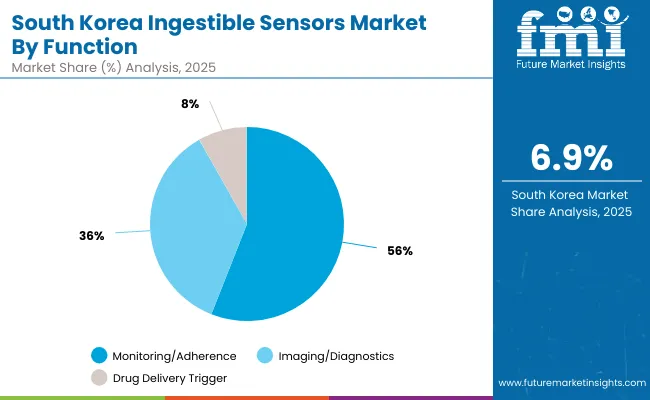
The ingestible sensors market in South Korea in 2025 is shaped by strong demand across core monitoring functions, reflecting both clinical prevalence and healthcare guidelines. Monitoring/Adherence applications account for the largest share at 56.0%, supported by high rates of chronic disease management, medication compliance initiatives, and increasing integration of digital health technologies to address treatment adherence challenges.
Imaging/Diagnostics follows with 35.8%, driven by the rising demand for non-invasive diagnostic solutions, heightened medical imaging awareness, and wider adoption of advanced sensor-based diagnostic protocols. Drug Delivery Trigger applications contribute 8.2%, supported by the established use of controlled release systems in medication management and growing integration of sensor technologies with therapeutic delivery systems.
This distribution reflects the growing emphasis on comprehensive patient monitoring and the expanding role of sensor technologies in both diagnostic and therapeutic applications within South Korea's healthcare system.
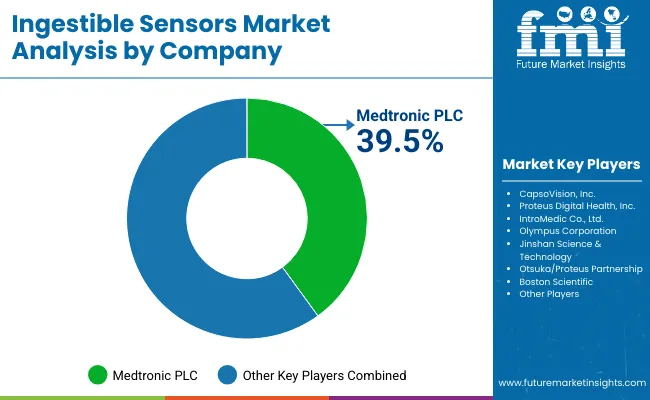
The ingestible sensors market is characterized by competition among established medical technology companies, specialty sensor manufacturers, and digital health focused firms. Companies are investing in sensor miniaturization, wireless communication technologies, regulatory compliance, and healthcare provider partnerships to deliver effective, safe, and accessible sensor solutions. Product development, clinical validation, and market access strategies are central to strengthening product portfolios and market presence.
Medtronic PLC leads the market with 39.5% global value share, offering clinically-proven ingestible sensor technologies with a focus on reliability and patient safety. Other players collectively account for 60.5% market share, including CapsoVision Inc., which provides comprehensive capsule endoscopy and imaging sensor products with emphasis on diagnostic accuracy.
Olympus Corporation operates with focus on bringing innovative sensor technologies to established endoscopy and diagnostic markets. Jinshan Science & Technology provides comprehensive sensor portfolios including monitoring products across multiple therapeutic areas. Boston Scientific provides sensor technologies and specialized devices to enhance market accessibility and patient access to essential monitoring capabilities.
Ingestible sensors are emerging as a transformative digital health technology with strong applications in medication adherence monitoring, chronic disease management, gastrointestinal diagnostics, and remote patient care. The market's advantages - non-invasive monitoring capabilities, real-time physiological data collection, and integration with digital health platforms - make ingestible sensors attractive to healthcare providers, pharmaceutical companies, and patients seeking alternatives to traditional monitoring methods. Scaling ingestible sensor commercialization requires coordinated action across regulatory agencies, clinical standards organizations, technology innovators, healthcare systems, and capital providers.
| Items | Values |
|---|---|
| Quantitative Units (2025) | USD 983.6 Million |
| Sensor Type | Temperature, Pressure, pH, Image/Imaging |
| Function | Monitoring/Adherence, Imaging/Diagnostics, Drug Delivery Trigger |
| End Use | Healthcare, Sports/Fitness, Military, Other End Use |
| Regions Covered | North America, Europe, East Asia, South Asia & Pacific, Latin America, Middle East & Africa |
| Countries Covered | United States, Canada, United Kingdom, Germany, France, China, Japan, South Korea, India, Brazil, Australia and 40+ countries |
| Key Companies Profiled | Medtronic PLC, CapsoVision Inc., IntroMedic Co. Ltd., Olympus Corporation, Jinshan Science & Technology, Boston Scientific |
| Additional Attributes | Dollar sales by sensor type and monitoring function, regional demand trends, competitive landscape, healthcare provider preferences for specific sensor technologies, integration with digital health platforms, innovations in wireless communication capabilities, patient compliance monitoring, and clinical outcome optimization |
The global Ingestible Sensors market is valued at USD 983.6 million in 2025.
The size of the Ingestible Sensors market is projected to reach USD 1,696.1 million by 2035.
The Ingestible Sensors market is expected to grow at a 5.6% CAGR between 2025 and 2035.
The key sensor type segments in the Ingestible Sensors market are Temperature, Pressure, pH, and Image/Imaging.
In terms of sensor type, the Temperature segment is set to command the dominant share in the Ingestible Sensors market in 2025.
Explore Similar Insights

Thank you!
You will receive an email from our Business Development Manager. Please be sure to check your SPAM/JUNK folder too.
Chat With
MaRIA